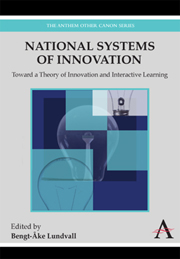Book contents
- Frontmatter
- Contents
- List of Tables
- List of Figures
- Preface
- 1 Introduction
- Part I Toward a New Approach to National Systems of Innovation
- 2 Institutional Learning
- 3 User-Producer Relationships, National Systems of Innovation and Internationalisation
- 4 Approaching National Systems of Innovation from the Production and Linkage Structure
- Part II A Closer Look at National Systems of Innovation
- Part III Opening National Systems of Innovation: Specialisation, Multinational Corporations and Integration
- Notes
- References
4 - Approaching National Systems of Innovation from the Production and Linkage Structure
from Part I - Toward a New Approach to National Systems of Innovation
Published online by Cambridge University Press: 05 March 2012
- Frontmatter
- Contents
- List of Tables
- List of Figures
- Preface
- 1 Introduction
- Part I Toward a New Approach to National Systems of Innovation
- 2 Institutional Learning
- 3 User-Producer Relationships, National Systems of Innovation and Internationalisation
- 4 Approaching National Systems of Innovation from the Production and Linkage Structure
- Part II A Closer Look at National Systems of Innovation
- Part III Opening National Systems of Innovation: Specialisation, Multinational Corporations and Integration
- Notes
- References
Summary
Introduction
Studies of national systems of innovation (NSI) often focus on the R&D system. This chapter will argue that less conspicuous production and sales/purchase activities are an alternative and, in many ways, more adequate point of departure. More specifically, the claim is that by shifting attention to the production and linkage patterns of nations a whole set of questions is raised and much can be said about rates and directions of innovative activities.
This chapter will develop this claim in several steps. First, the basic approach and the analytical elements of the analysis of NSI are sketched (section 4.2) and the background of the approach is discussed (section 4.3). Then the two sides of the approach are treated: production structure and ‘simple’ learning (section 4.4), and linkage structure and interactive learning which includes the special case of development blocks and their structural tensions (section 4.5).
The Basic Approach
Behind the production and linkage approach to NSI is the postulate that most of what is normally classified as ‘innovation’ is closely related to existing products and processes. We find first of all that new possibilities are often discovered as more or less unconscious by-products of production and sales activities. Second, more ambitious and conscious searching for and learning about new products and processes quite often start with the problems of existing products and processes, which may be conceptualised as two lists of possible demand specifications accumulated since the last shift of product or process: one list containing errors, repair problems and larger breakdowns and another list of ideas and wishes for new features, facilities, performance measures etc.
- Type
- Chapter
- Information
- National Systems of InnovationToward a Theory of Innovation and Interactive Learning, pp. 71 - 96Publisher: Anthem PressPrint publication year: 2010
- 3
- Cited by



